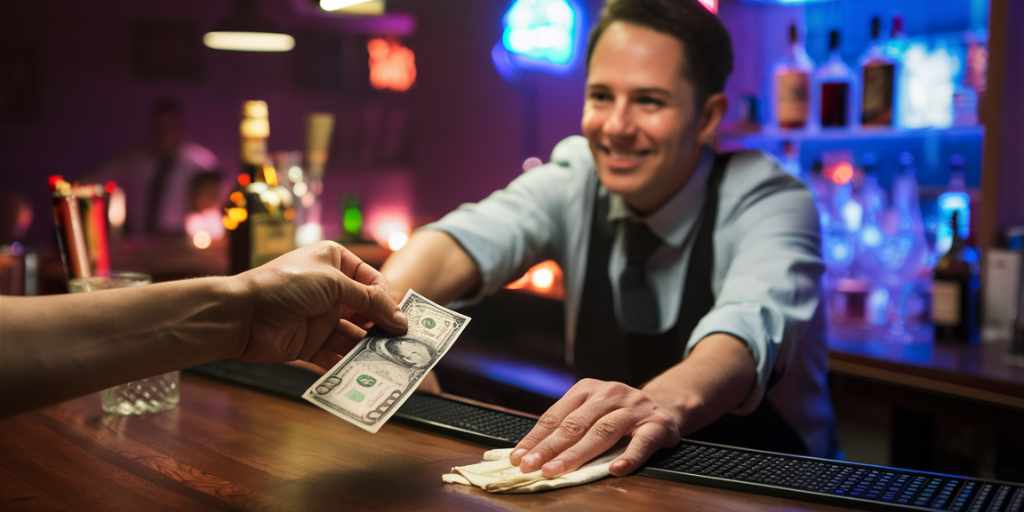Embarking on a night out at the bar? Key to any memorable evening is knowing ‘how do you drink responsibly at a bar.’ This essential guide equips you with no-nonsense advice to moderate your alcohol intake, enjoy the moment, and still wake up feeling good the next day. From choosing the right drinks to knowing when to say no, we’ve got your back—let’s dive in.
Key Takeaways
- Understand standard drink sizes and choose lower alcohol options to control intake while being cautious with drinks high in alcohol content.
- Pace drinking to one standard drink per hour, taking into account body weight and hydrating with water to manage alcohol’s effects.
- Formulate a personal drinking plan, set boundaries to handle peer pressure, and ensure safe transportation, such as a designated driver or rideshare services.
Navigating Bar Menus Mindfully

The first step towards responsible drinking is getting a good grasp of what you’re consuming. The bar menu can often seem like a labyrinth of unfamiliar names and concoctions. It’s easy to overlook the fact that not all drinks are created equal, especially when it comes to alcohol content. The key is to understand the standard drink sizes, choose lower alcohol options, and beware of potent potables.
This doesn’t mean you have to limit yourself to light beers or virgin cocktails. Rather, it’s about making informed choices and understanding how different drinks can influence your alcohol intake. This way, you can enjoy a variety of drinks while keeping your alcohol consumption in check.
Know Your Standard Drink Sizes
Controlling your alcohol intake can be effectively achieved by familiarizing yourself with standard drink sizes. This knowledge helps you understand exactly how much alcohol you’re consuming, preventing accidental overindulgence. It’s easy to underestimate the amount of alcohol in a mixed drink or a glass of wine, but knowing the standard sizes can keep you informed and in control.
Whether you’re a fan of beer, wine, or spirits, being aware of standard drink sizes is crucial. In the United States, a standard drink is approximately 0.6 fluid ounces or 14 grams of pure alcohol. This equals to about 12 ounces of beer, 5 ounces of wine, or 1.5 ounces of spirits. With this understanding, you can better monitor your alcohol intake and ensure responsible drinking.
Choose Lower Alcohol Options
Another practical approach to responsible drinking is opting for beverages with a lower alcohol content. This doesn’t necessarily mean sacrificing taste or enjoyment – many lower alcohol options still offer delightful flavours and can be just as satisfying as their stronger counterparts.
The variation in alcohol content among different types of drinks is significant. For instance, a light beer can have an alcohol content as low as 3-4%, while certain types of wine and spirits can contain up to 40-50% alcohol. By opting for beverages with lower alcohol content, you can enjoy your night out while reducing your overall alcohol intake, thus promoting responsible drinking habits.
Beware of Potent Potables
Cocktails and craft beers can add an exciting dimension to your bar experience, but it’s essential to approach potent potables with caution. These are drinks that have a higher concentration of alcohol by volume, and they can significantly increase your alcohol intake.
Potent potables can include anything from strong spirits like vodka and whiskey to certain craft beers with high alcohol content. Consuming these drinks quickly and in large quantities can lead to a rapid increase in blood alcohol concentration, resulting in potential health risks. Being aware of the potency of your drink allows you to enjoy a variety of beverages responsibly without compromising your health and safety.
Pacing Yourself: The One-Drink-Per-Hour Rule

Maintaining a steady pace is integral to drinking responsibly. It’s easy to lose track of how much you’re drinking, especially when you’re in a social setting. This is where the one-drink-per-hour rule comes in handy.
The one-drink-per-hour rule is based on the average time it takes for the body to metabolize one standard drink, which is approximately one hour. This pacing helps ensure that alcohol levels in the blood do not rise too quickly, preventing the harmful effects of rapid intoxication. It’s a practical guideline that can help you enjoy your night out without crossing the line into over-consumption.
Understand Your Body Weight’s Role
Your body weight holds significant importance in determining how your body consumes alcohol. Just as your weight can affect how you respond to medications or how quickly you metabolize food, it can also impact how your body processes alcohol.
Individuals with lower body weight are more susceptible to the effects of alcohol due to higher blood alcohol concentration. This means that if two people consume the same amount of alcohol, the person with the lower body weight will likely feel the effects of alcohol more intensely. Therefore, it’s important to take your body weight into account when planning your alcohol consumption for the night.
The Importance of Drinking Water
Keeping hydrated, although often overlooked, is a crucial component of responsible drinking. Alcohol is a diuretic, meaning it increases urine production and can lead to dehydration if not balanced with water intake.
While drinking water won’t directly speed up the breakdown of alcohol in your body, it can assist in managing its effects. Maintaining hydration can help to dilute alcohol in the bloodstream, potentially decreasing its concentration.
It’s recommended to have at least one 16-ounce glass of water with every 12-ounce beer or 4 to 6 ounces of liquor. This simple practice can help you drink responsibly and reduce the impact of a potential hangover.
Combating Peer Pressure at the Bar

Peer pressure is a common element in bar settings. Whether it’s a friend insisting on rounds of shots, or a group game that involves drinking, it’s easy to consume more than intended. Learning to combat peer pressure is a crucial aspect of responsible drinking.
Resisting peer pressure doesn’t mean you have to miss out on the fun – it’s about setting your boundaries and sticking to them. By planning ahead, recognizing different types of pressure, and avoiding them when possible, you can ensure that you’re drinking on your own terms, not because of external influences.
Mastering the Art of Saying No
In social settings, it can occasionally be difficult to decline a drink offer. But mastering the art of saying ‘no’ is an essential skill for responsible drinking. Whether it’s having excuses ready, opting for a non-alcoholic drink, or simply being honest about your decision, there are many effective strategies for declining a drink.
And remember, it’s your choice – you don’t have to drink just because others are, or because you’re being encouraged to. Being confident in your decision not to drink is a key part of responsible drinking.
Avoid Drinking Games
Many social gatherings prominently feature drinking games as a form of entertainment. However, they can often lead to excessive drinking and rapid intoxication, which may result in binge drinking. Therefore, avoiding drinking games is an important strategy for drinking responsibly.
While the games themselves can be fun, they often encourage binge drinking, as participants tend to consume large amounts of alcohol in a short period, increasing the risk of negative health effects. Instead of partaking in drinking games, consider other forms of entertainment that don’t involve alcohol, or play the game with a non-alcoholic beverage.
Eating Before and During Bar Visits

You might have noticed that alcohol tends to have a stronger effect on an empty stomach. There’s a scientific reason for this. Consuming food, especially those high in protein can slow down the absorption of alcohol into the bloodstream, reducing its immediate effects.
Before heading to a bar, consider having a meal. Some excellent options include:
- Spinach
- Avocado
- Potatoes
- Lentils
- Milk
- Yogurt
- Olives
- Nuts
- Chickpeas
- Bread
- Hummus
- Oats
These foods not only provide essential nutrients but also help in slowing down the absorption of alcohol, making you less susceptible to its effects.
Remember, eating is not cheating; it’s a key part of responsible drinking.
Recognizing When to Stop Drinking

Recognizing when to put a halt to your drinking is a key element of responsible consumption. This means being able to recognize when you’ve had enough and taking the necessary steps to stop consuming more alcohol.
Signs of too much alcohol consumption, which may indicate alcohol abuse, alcohol poisoning, or liver disease, include:
- Mental confusion
- Difficulty remaining conscious
- Vomiting
- Seizures
- Trouble breathing
- Slow heart rate
- Clammy skin
If you start to experience these symptoms, it’s a clear indication that you need to stop drinking. Remember, it’s always better to be safe than sorry, and understanding your limits is a key aspect of responsible drinking.
Planning Safe Transportation
Securing a safe way home is vital after a night of drinking. Driving under the influence is not only illegal, but it’s also extremely dangerous and can lead to serious consequences.
Whether it’s designating a sober driver or using a rideshare service, planning safe transportation is a key aspect of responsible drinking. It not only ensures your safety but also the safety of others on the road.
Designated Driver Strategy
A reliable way to guarantee safe transportation after a night out for you and your friends is by having a designated driver. This person chooses to stay sober for the evening and is responsible for driving others home.
A designated driver needs to be someone who is responsible and reliable. They need to take their role seriously and be strong enough to resist the allure of alcohol. If you’re planning a night out with a group, consider rotating the role of designated driver among your friends. This way, everyone can enjoy their night without worrying about driving home.
Utilizing Rideshare Services
Rideshare services present a solid alternative for safe transportation if designating a driver isn’t feasible. With companies like Uber and Lyft, you can request a ride with just a few taps on your smartphone, ensuring a safe trip home without the risks associated with drunk driving.
Rideshare apps also come with safety features like driver profiles, real-time location sharing, and 24/7 customer support, providing an added layer of security. So if you’ve been drinking, don’t get behind the wheel – instead, utilize a rideshare service to ensure both your safety and the safety of others on the road.
Handling Alcoholic Beverages with Care
Another essential aspect of responsible drinking is careful handling of your alcoholic beverages. This means not only being mindful of how much you’re drinking, but also ensuring that your drink is safe to consume, like a responsible drinker.
Whether you’re at a crowded bar or a house party, here are some important safety tips to keep in mind:
- Never leave your drink unattended
- Be wary of accepting drinks from strangers
- If you suspect that your drink has been tampered with, it’s always safer to discard it and get a new one
Remember, your safety should always be your top priority.
Creating a Personal Drinking Plan
To effectively manage your alcohol consumption and prevent alcohol use disorder, consider developing a personal drinking plan. This involves setting clear goals for yourself, understanding your motivations, and strategizing how to achieve them.
Your drinking plan could involve:
- Setting limits on the amount of alcohol you consume each week
- Deciding to abstain from alcohol on certain days
- Planning alternative activities that don’t involve drinking
- Developing strategies to deal with peer pressure
Whatever your plan involves, the important thing is that it helps you to drink responsibly and enjoy your social life without the risks associated with excessive alcohol consumption.
Alternatives to Alcoholic Drinks
Despite alcoholic beverages often being at the heart of social events, a plethora of enjoyable alternatives exist. Non-alcoholic beers, wines, and mocktails offer the fun and flavour of their alcoholic counterparts without the potential negative effects of mixed alcohol.
Whether you’re taking a break from alcohol, designated as the driver, or simply prefer not to drink, these alternatives can make you feel included in the festivities. After all, being social doesn’t require alcohol – it’s all about enjoying the company of friends and having a good time.
Summary
Navigating the world of responsible drinking may seem daunting at first, but with the right knowledge and strategies, it can become second nature. Remember, the aim is not to forego the enjoyment that comes with social drinking but rather to ensure that this enjoyment does not come at the expense of your health and safety.
So, whether it’s understanding standard drink sizes, pacing yourself, eating before and during bar visits, or planning safe transportation, each decision you make contributes to a safer, happier night out. The key is to remain informed, make conscious choices, and, most importantly, know your limits. Here’s to responsible drinking and memorable nights out!
Frequently Asked Questions
What are the rules for drinking responsibly?
To drink responsibly, minimize alcohol consumption, and never drink and drive. It’s important to have a designated driver or take a taxi if needed, as well as avoid drinking on an empty stomach.
What is proper drinking etiquette?
Proper drinking etiquette involves finishing your food before taking a sip to avoid being seen as uncultured, especially in American culture. Remember to chew first and then drink.
What is a standard drink size?
A standard drink size in the United States is any beverage containing 0.6 oz of ethanol. This is an important guideline to keep in mind when monitoring alcohol consumption.
What is the one-drink-per-hour rule?
The one-drink-per-hour rule is based on the average time it takes for the body to metabolize one standard drink, which is approximately one hour. It’s a guideline to help manage alcohol intake responsibly.
How does body weight impact alcohol absorption?
Body weight impacts alcohol absorption, with lower body weight individuals being more susceptible to alcohol effects due to higher blood alcohol concentration.




